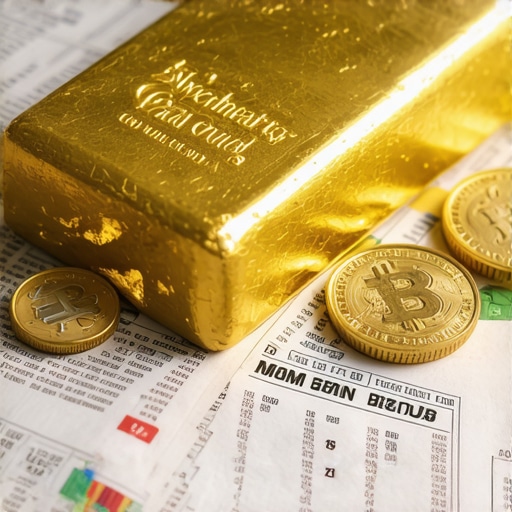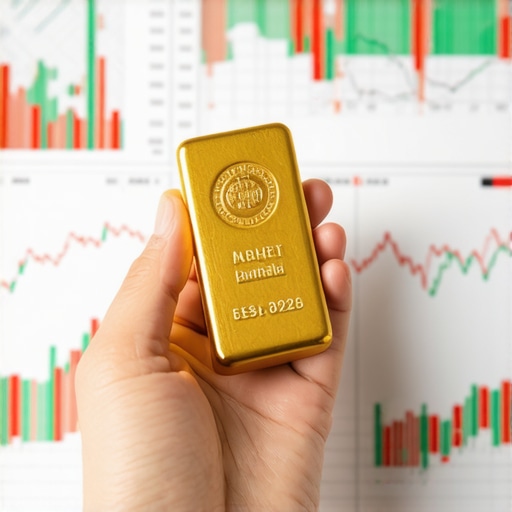Embarking on Your Golden Journey: Why Start Investing in Gold?
For beginners, the idea of investing in gold can seem both alluring and complex. Gold’s timeless appeal as a store of value and hedge against inflation makes it a compelling addition to any investment portfolio. Yet, understanding how to navigate the gold market requires more than just buying shiny metal—it demands strategy, knowledge, and a clear step-by-step approach.
Decoding the Spectrum: Exploring Diverse Gold Investment Avenues
Gold investment isn’t monolithic. From physical gold bars and coins to Exchange-Traded Funds (ETFs) and futures, each investment type offers unique advantages and considerations. Physical gold provides tangible security but requires safe storage solutions, while gold ETFs deliver liquidity and ease of trading without the hassle of handling metal. Futures contracts, though complex, offer leveraged exposure and profit opportunities for savvy investors willing to understand market dynamics.
How Do I Choose the Right Type of Gold Investment for a Beginner?
Choosing the right investment vehicle depends on your financial goals, risk tolerance, and investment horizon. Beginners often find gold ETFs or mutual funds more accessible, as they require less upfront capital and offer diversification benefits. Physical gold suits those seeking a tangible asset but entails storage and insurance costs. Futures and mining stocks cater to more experienced investors comfortable with higher volatility and market timing.
Step-by-Step Blueprint: Initiating Your Gold Investment
1. Assess Your Financial Landscape and Objectives
Before investing, clarify your financial goals, investment timeline, and risk appetite. Gold is typically a long-term hedge, so understanding where it fits in your portfolio is vital.
2. Educate Yourself on Gold Market Nuances
Knowledge is power. Dive into market trends, price drivers like supply-demand dynamics, and geopolitical factors influencing gold prices. Resources such as the World Gold Council offer authoritative insights.
3. Select a Trusted Dealer or Platform
For physical gold, choose reputable dealers with transparent pricing and authenticity guarantees. When opting for ETFs or mutual funds, use regulated brokerage platforms with robust security.
4. Decide on the Investment Amount and Purchase Method
Start with an amount comfortable to you, considering fees and storage costs for physical gold or expense ratios for funds. Consider incremental investments to mitigate market timing risks.
5. Secure Storage and Regular Portfolio Review
If holding physical gold, invest in secure storage solutions—be it a bank safe deposit box or professional vault services—to protect your assets. Regularly review your gold investment’s performance and adjust as market conditions evolve. For more on secure physical gold acquisition, see Physical Gold Investment Strategies.
Expert Tip: Balancing Gold Within a Diversified Portfolio
Gold’s role as a portfolio diversifier and inflation hedge is well-documented. However, its performance can be cyclical and influenced by macroeconomic variables. Experts recommend allocating between 5% to 15% of your portfolio in gold to optimize risk-adjusted returns without overexposure.
Unlocking Insights: What Are the Risks and Rewards of Gold Investment?
While gold is often seen as a safe haven, it is not without risks. Price volatility, storage costs, and liquidity constraints (especially for physical gold) can impact returns. Conversely, gold shines during economic uncertainty, currency devaluation, and geopolitical tensions, preserving wealth when other assets falter.
For a deeper dive into gold’s investment benefits and strategic allocation, explore Effective Gold Investment Strategies to Hedge Against Inflation.
Join the Conversation: Share Your Gold Investment Experiences and Questions!
Your journey into gold investment is unique, and sharing insights or queries can empower others. Feel free to comment below with your questions or success stories to foster a community of informed investors.
Reflecting on Gold Investment Risks: My Personal Experience
When I first ventured into gold investing, I quickly realized that the journey wasn’t as straightforward as simply buying and holding. One of the biggest lessons was understanding the volatility of gold prices. While gold is often touted as a safe haven, it can experience sharp fluctuations—sometimes driven by unexpected geopolitical events or sudden shifts in currency values. For example, during the early stages of the COVID-19 pandemic, gold prices surged, but there were moments of rapid correction that caught many off guard, myself included.
Storage costs for physical gold also became a practical consideration I hadn’t initially anticipated. I learned that securing my assets in a reputable vault was essential to prevent theft or damage, but this added a recurring expense to my investment. This is why, for some investors, especially beginners, gold ETFs or mutual funds can provide a more hassle-free alternative, offering exposure without the worries of safekeeping.
Strategizing Your Gold Investment: Insights Beyond the Basics
One strategy that transformed my approach was dollar-cost averaging. Instead of investing a lump sum at once, I began purchasing gold incrementally, smoothing out the effects of market volatility. This approach reduced the stress of timing the market perfectly and allowed me to build my position steadily over time.
Additionally, I diversified within the gold sector itself. Alongside physical gold, I explored gold mining stocks and ETFs, which added a layer of growth potential to my portfolio. However, I remained cautious, knowing that mining stocks come with their own risks tied to operational performance and commodity cycles.
What Are the Lesser-Known Factors That Impact Gold Prices?
Beyond the commonly discussed inflation and currency fluctuations, I discovered that factors like central bank policies, mining supply disruptions, and even technological advancements in gold extraction can influence prices. For instance, the World Gold Council highlights how shifts in gold demand from emerging markets or changes in jewelry consumption patterns can sway market dynamics (World Gold Council Gold Demand Trends).
Understanding these nuances helped me appreciate that gold investing requires ongoing education and attentiveness to global economic signals. It’s not just about reacting to price changes but anticipating potential drivers behind them.
Integrating Gold Wisely: Practical Tips from My Investment Journey
From my experience, balancing gold within a diversified portfolio is vital. I found that allocating around 10% to gold helped cushion my investments during market downturns without sacrificing growth potential elsewhere. This allocation also aligned well with my risk tolerance and long-term financial goals.
Moreover, I encourage fellow investors to regularly review their gold holdings in the context of broader market shifts and personal circumstances. This habit ensures your gold investment remains aligned with your objectives and adapts to changing economic landscapes.
If you’re curious to explore more about securing your physical gold investments and effective strategies, I recommend checking out this detailed guide on Physical Gold Investment Strategies.
Join the Gold Investment Discussion: What Has Your Experience Taught You?
Every gold investor’s journey is unique, filled with lessons learned and strategies refined. Have you faced unexpected challenges or uncovered tips that reshaped your approach? Share your stories or questions below—let’s build a community that supports and empowers smart gold investing!
Harnessing Macro Trends: Advanced Analytical Approaches to Gold Price Forecasting
Gold investment success hinges not only on understanding basic supply-demand dynamics but also on interpreting complex macroeconomic indicators. Savvy investors delve into interest rate trajectories, real yields, and central bank gold reserve policies to anticipate price movements. For example, the inverse relationship between real interest rates and gold prices often signals potential bullish phases for gold when real yields dip below zero.
Moreover, geopolitical risk indices and currency strength metrics provide additional layers of insight. During heightened geopolitical tensions, gold typically benefits as a safe haven. Yet, discerning the intensity and duration of such events can refine timing strategies and position sizing. Tools such as the CBOE Volatility Index (VIX) often correlate inversely with equity markets and can serve as proxies for risk sentiment impacting gold demand.
Strategic Diversification within Gold Assets: Mining Stocks, ETFs, and Beyond
Investing solely in physical gold or bullion ETFs may limit exposure to growth potential inherent in the gold sector. Incorporating gold mining equities introduces leverage to gold price movements, as mining profitability can amplify returns during price upswings. However, this approach also exposes investors to operational risks, regulatory changes, and geopolitical instability in mining regions.
To mitigate such risks, consider diversified gold-focused ETFs that blend physical gold holdings with mining stocks, balancing stability and growth. For instance, funds like the VanEck Vectors Gold Miners ETF (GDX) offer exposure to a broad portfolio of leading gold producers with varying operational footprints.
How Can Sophisticated Investors Manage Gold Investment Volatility Effectively?
Volatility is intrinsic to gold markets, influenced by global monetary policies, macroeconomic shocks, and investor sentiment shifts. Sophisticated investors employ several techniques to manage this volatility:
- Options Strategies: Utilizing gold options contracts can hedge downside risk or speculate on price movements with defined risk parameters.
- Dynamic Portfolio Rebalancing: Regularly adjusting gold allocations in response to volatility metrics and market signals helps maintain optimal risk-return balance.
- Correlation Analysis: Monitoring correlations between gold and other asset classes enables tactical shifts to exploit diversification benefits during turbulent periods.
Emphasizing disciplined risk management and leveraging advanced financial instruments elevates gold investing beyond simple buy-and-hold tactics.
Integrating Technological Innovations: Blockchain and Digital Gold Tokens
The advent of blockchain technology has introduced innovative pathways for gold investment, notably through tokenized gold assets. These digital tokens represent ownership of physical gold stored securely in vaults, offering benefits such as fractional ownership, enhanced liquidity, and lower transaction costs.
Platforms like Paxos have pioneered regulated gold-backed tokens, enabling investors to trade gold 24/7 on digital exchanges without dealing with physical delivery complexities. This integration of fintech and precious metals opens new frontiers in accessibility and portfolio diversification.
Masterclass Insight: Leveraging Behavioral Finance to Enhance Gold Investment Decisions
Behavioral biases such as herd mentality and overreaction to short-term volatility often affect gold investors, leading to suboptimal timing and allocation. Advanced investors cultivate awareness of these cognitive pitfalls, employing systematic investment plans and data-driven decision frameworks to mitigate emotional influences.
Utilizing quantitative models and algorithmic signals can further refine entry and exit points, ensuring decisions align with long-term strategic goals rather than transient market noise.
Deep Dive Reference: What Are the Long-Term Macroeconomic Drivers Behind Gold’s Role as a Safe Haven?
Gold’s status as a safe haven is underpinned by enduring macroeconomic drivers including currency debasement, inflationary cycles, and systemic financial risks. The International Monetary Fund’s research on global reserve diversification highlights how central banks adjust gold reserves in response to shifts in geopolitical alliances and monetary policy stances (IMF Working Paper on Gold as a Reserve Asset).
Understanding these long-term structural forces equips investors with a strategic vantage point to position gold appropriately within evolving economic paradigms.
Ready to elevate your gold investment approach? Explore our advanced guides and connect with experts to tailor a strategy that aligns with your sophisticated financial goals.
Harnessing Market Sentiment: Applying Behavioral Finance to Gold Investment
Understanding the psychological undercurrents that influence gold market behavior is crucial for advanced investors seeking to optimize returns. Cognitive biases such as loss aversion and confirmation bias can skew perception during volatile periods, leading to premature selling or overexposure. Incorporating behavioral finance principles enables investors to implement disciplined strategies that counteract emotional decision-making, fostering steadier portfolio growth.
Tokenization and Blockchain: The Future of Accessible Gold Investments
The integration of blockchain technology has revolutionized gold investment by enabling tokenization—digital representations of physical gold holdings. This technological advancement provides unparalleled liquidity, fractional ownership, and transparent audit trails, democratizing access to gold regardless of investment size. Platforms like Paxos exemplify regulated environments where investors can buy, sell, and transfer gold tokens seamlessly, bypassing traditional barriers such as storage and authentication.
How Does Tokenized Gold Compare with Traditional Physical Gold Ownership?
Tokenized gold offers several advantages over physical gold, including instant settlement, reduced transaction costs, and elimination of storage risks. However, it introduces dependence on platform security and regulatory compliance. Traditional physical gold remains favored for those prioritizing tangible asset control and privacy. A hybrid approach, combining tokenized gold for liquidity and physical gold for security, can optimize portfolio resilience.
For further rigorous analysis, refer to the International Monetary Fund’s comprehensive study on gold’s evolving role in global finance (IMF Working Paper on Gold as a Reserve Asset), which provides empirical data and strategic insights valuable for institutional and individual investors alike.
Dynamic Hedging and Volatility Management: Techniques for Sophisticated Investors
Expert gold investors employ dynamic hedging techniques, including options strategies such as protective puts and covered calls, to mitigate downside risks while preserving upside potential. Coupling these with real-time volatility analysis and correlation tracking against equities and currencies allows for tactical rebalancing that adapts to shifting market conditions. This proactive approach reduces exposure during turbulent phases and capitalizes on favorable trends.
Embracing Macro Drivers: Long-Term Strategic Positioning in Gold
Anticipating gold’s trajectory requires deep analysis of macroeconomic drivers beyond immediate market noise. Key indicators include real interest rate movements, quantitative easing policies, and shifts in central bank reserve allocations. Tracking these variables empowers investors to position their gold holdings tactically, aligning investment timing with broader economic cycles and geopolitical developments.
Engage with these advanced perspectives to refine your gold investment strategy and achieve superior portfolio performance. Join our expert community to exchange insights and access tailored resources that elevate your investment acumen.
Frequently Asked Questions (FAQ)
What are the main advantages of investing in gold compared to other assets?
Gold serves as a hedge against inflation, a store of value during economic uncertainty, and a portfolio diversifier due to its low correlation with stocks and bonds. Unlike fiat currencies, gold is a tangible asset with intrinsic value recognized globally, making it a reliable safe haven in volatile markets.
How can beginners start investing in gold without dealing with physical storage?
Beginners can consider gold Exchange-Traded Funds (ETFs), mutual funds, or digital gold tokens. These investment vehicles provide exposure to gold prices without the complexities of physical storage, security, and insurance, offering liquidity and ease of transaction through regulated brokerage platforms.
What risks should investors be aware of when holding physical gold?
Physical gold entails risks such as theft, storage costs, insurance expenses, and liquidity challenges when selling. Additionally, transaction fees and authenticity concerns necessitate purchasing from reputable dealers. Proper vault storage and periodic portfolio reviews are vital to mitigate these risks.
How do macroeconomic factors influence gold prices?
Gold prices respond to inflation rates, real interest rates, currency fluctuations, central bank policies, and geopolitical tensions. For example, lower or negative real yields generally increase gold’s appeal, while strong currencies or rising interest rates may suppress prices. Understanding these dynamics helps in timing and positioning gold investments.
Is investing in gold mining stocks riskier than owning physical gold?
Yes, gold mining stocks carry additional risks including operational performance, regulatory environment, geopolitical stability in mining regions, and commodity cycle volatility. However, they offer leveraged exposure to gold prices and potential for higher returns, making them suitable for investors willing to accept greater risk.
What is the role of tokenized gold, and how does it compare to traditional gold investments?
Tokenized gold represents physical gold ownership via blockchain-based digital tokens, providing benefits like fractional ownership, enhanced liquidity, and lower transaction costs. While it eliminates storage and authentication hassles, it depends on platform security and regulatory frameworks, contrasting with the tangible control of physical gold.
How can investors manage volatility in gold investments effectively?
Volatility management strategies include using options contracts for hedging, dynamic portfolio rebalancing to adjust exposure based on market conditions, and correlation analysis with other assets. Behavioral finance awareness also helps investors avoid emotional decisions that exacerbate volatility impacts.
What percentage of a diversified portfolio should be allocated to gold?
Experts generally recommend allocating between 5% to 15% of a portfolio to gold to optimize risk-adjusted returns while avoiding overexposure. Individual allocation depends on risk tolerance, investment horizon, and overall financial goals.
How does dollar-cost averaging benefit gold investors?
Dollar-cost averaging involves investing fixed amounts at regular intervals, reducing the impact of price volatility and timing risks. This approach helps build positions steadily and mitigates emotional reactions to market fluctuations, fostering disciplined investment behavior.
What behavioral biases commonly affect gold investors, and how can they be overcome?
Biases such as herd mentality, loss aversion, and confirmation bias can lead to premature selling or overbuying. Investors can counter these by implementing systematic investment plans, relying on data-driven decision-making, and leveraging quantitative models to maintain alignment with long-term objectives.
Trusted External Sources
- World Gold Council – A leading authority on gold market data, trends, and investment insights, offering comprehensive research on gold demand dynamics and strategic allocation recommendations.
- International Monetary Fund (IMF) – Provides in-depth analyses on gold’s role as a reserve asset and macroeconomic impacts, valuable for understanding long-term structural drivers in gold investing.
- CBOE Volatility Index (VIX) – Offers insights into market volatility and investor sentiment, which can be correlated with gold price movements to inform timing and risk management.
- Paxos – A pioneer in regulated blockchain-based gold tokenization, demonstrating the intersection of fintech and precious metals investment.
- VanEck Vectors Gold Miners ETF (GDX) – An example of diversified gold mining equities exposure, useful for investors seeking growth potential within the gold sector.
Conclusion
Investing in gold remains a multifaceted endeavor that integrates timeless principles with modern innovations. From physical bullion to ETFs, mining stocks, and tokenized assets, each approach offers distinct benefits and risks tailored to varying investor profiles. Understanding macroeconomic drivers, managing volatility with sophisticated tools, and recognizing behavioral biases empowers investors to optimize gold’s role within diversified portfolios. By strategically allocating gold—commonly between 5% and 15%—and employing disciplined investment frameworks such as dollar-cost averaging, investors can harness gold’s unique capacity to preserve wealth amid economic uncertainty. As the gold investment landscape evolves with technological advancements like blockchain tokenization, staying informed and adaptable is paramount. Engage with trusted sources, share experiences, and continually refine your strategy to unlock gold’s full potential. Ready to deepen your expertise? Share your insights, explore related expert content, and embark confidently on your gold investment journey today!










